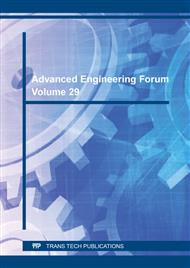[1]
K. Tanie, in: Humanoid Robot and its Application Possibility, Proc. of IEEE Int. Conf. on Multisensor Fusion and Integration for Intelligent Systems, Tokyo, Japan (2003), pp.213-214.
DOI: 10.1109/mfi-2003.2003.1232659
Google Scholar
[2]
H. Kondo, Y. Ogura, H. Aikawa, A. Morishima, J. Shimizu, H. Lim, and A. Takanishi, in: Application of biped humanoid robot to simulate the motion of elderly and disable people, Gerontechnology (2008), vol. 7, p.143.
DOI: 10.4017/gt.2008.07.02.080.00
Google Scholar
[3]
K. Muecke, and D. Hong, in: Constrained analytical trajectory filter for stabilizing humanoid robot motions, Intelligent Service Robotics (2011), vol. 4, pp.203-218.
DOI: 10.1007/s11370-011-0094-7
Google Scholar
[4]
S. Kajita, K. Kaneko, M. Morisawa, S. Nakaoka, and H. Hirukawa, in: ZMP-based biped running enhanced by toe springs, Proc. of the IEEE Int. Conf. on Robotics and Automation, Roma, Italy (2007), pp.3963-3969.
DOI: 10.1109/robot.2007.364087
Google Scholar
[5]
D. Torricelli, J. Gonzalez, M. Weckx, R. Jiménez-Fabián, B. Vanderborght, M. Sartori, S. Dosen, D. Farina, D. Lefeber, and J.L. Pons, in: Human-like compliant locomotion: State of the art of robotic implementations, Bioinspiration and Biomimetics (2016).
DOI: 10.1088/1748-3190/11/5/051002
Google Scholar
[6]
E. Kouchaki, and M. J. Sadigh, in: Effect of toe-joint bending on biped gait performance, Proc. of the IEEE Int. Conf. on Robotics and Biomimetics, Tianjin, China (2010), pp.697-702.
DOI: 10.1109/robio.2010.5723411
Google Scholar
[7]
M. Sadedel, A. Yousefi-Koma, M. Khadiv, and M. Mahdavian, in: Adding low-cost passive toe joints to the feet structure of SURENA III humanoid robot, Robotica, pp.1-23.
DOI: 10.1017/s026357471600059x
Google Scholar
[8]
K. Narioka, T. Homma, and K. Hosoda, in: Humanlike ankle-foot complex for a biped robot, Proc. of the 12th IEEE-RAS Int. Conf. on Humanoid Robots, Japan (2012), pp.15-20.
DOI: 10.1109/humanoids.2012.6651493
Google Scholar
[9]
K. Nerakae, and H. Hasegawa, in: Big toe sizing design of small biped robot by using gait generation method, Applied Mechanics and Materials (2014), vol. 541-542, pp.1079-1086.
DOI: 10.4028/www.scientific.net/amm.541-542.1079
Google Scholar
[10]
A. Hof in: The equations of motion for a standing human reveal three mechanisms for balance, J. of Biomechanics (2014), vol. 40, pp.451-457.
DOI: 10.1016/j.jbiomech.2005.12.016
Google Scholar
[11]
K. Liu, and A. Tovar, in: An efficient 3D topology optimization code written in Matlab, Structural and Multidisciplinary Optimization (2014), vol. 50, pp.1175-1196.
DOI: 10.1007/s00158-014-1107-x
Google Scholar
[12]
S. M. Bruijn, O. G. Meijer, P. J. Beek, and J. H. van Dieën, in: The effects of arm swing on human gait stability, J. of Experimental Biology (2010), vol. 213, pp.3945-3952.
DOI: 10.1242/jeb.045112
Google Scholar
[13]
M. Pijnappels, I. Kingma, D. Wezenberg, G. Reurink, and J. H. van Dieën, in: Armed against falls: the contribution of arm movements to balance recovery after tripping, Experimental Brain Research (2010), vol. 201, pp.689-699.
DOI: 10.1007/s00221-009-2088-7
Google Scholar
[14]
D. S. Marigold, A. J. Bethune, and A. E. Patla, in: Role of the unperturbed limb and arms in the reactive recovery response to an unexpected slip during locomotion, J. of Neurophysiology (2003), vol. 89, pp.1727-1737.
DOI: 10.1152/jn.00683.2002
Google Scholar
[15]
H. Elftman, in: The function of arms in walking, Human Biology (2003), vol. 11, pp.529-535.
Google Scholar
[16]
R. N. Hinrichs, and P. R. Cavanagh, in: Upper Extremity Function in Treadmill Walking, Annual meeting of the American College of Sports Medicine, Miami, FL (1981).
Google Scholar
[17]
J. Park, in: Synthesis of natural arm swing motion in human bipedal walking, J. of Biomechanics (2008), vol. 41, pp.1417-1426.
DOI: 10.1016/j.jbiomech.2008.02.031
Google Scholar
[18]
J. Perry, and J. M. Burnfield, in: Gait Analysis: Normal and Pathological Function, 2nd Ed. Slack Incorporated (2010), p.82.
Google Scholar
[19]
M. W. Whittle, in: An Introduction to Gait Analysis, 4th Ed. Oxford (2007), p.59.
Google Scholar
[20]
N. Ito, and H. Hasegawa, in: The Robust Design to Generate the Gait Pattern of a Small Biped Robot, Japan Society for Design Engineering (2010), vol. 45, no. 6, pp.48-55.
Google Scholar
[21]
K. Nerakae, and H. Hasegawa, in: Simulation Based Design Optimization Framework for a Gait Pattern Generation of a Small Biped Robot with Tiptoe mechanism, Proc. of the 10th Int. Conf. on Modelling and Applied Simulation, Rome (2014), pp.295-302.
Google Scholar
[22]
T. Bui, H. Pham, and H. Hasegawa, in: Improve self-adaptive control parameters in differential evolution for solving constrained engineering optimization problems, J. of Computational Science and Technology (2013), vol. 7, no. 1, pp.59-74.
DOI: 10.1299/jcst.7.59
Google Scholar
[23]
M. S. Orendurff, A. D. Segal, J. S. Berge, K. C. Flick, D. Spanier, and G. K. Klute, in: The kinematics and kinetics of turning: limb asymmetries associated with walking a circular path, Gait and Posture (2006), vol. 23, pp.106-111.
DOI: 10.1016/j.gaitpost.2004.12.008
Google Scholar


